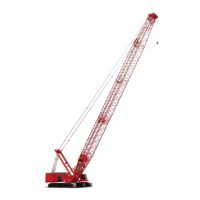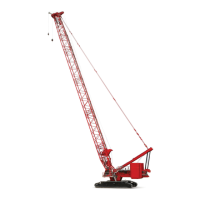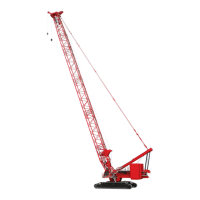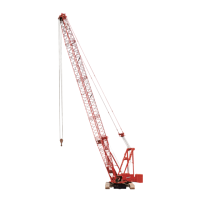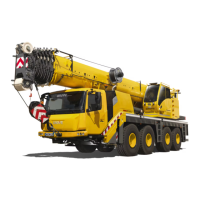HOISTS MLC80A-1/MLC90A-1/MLC100A-1/MLC100-1 SERVICE/MAINTENANCE MANUAL
5-2
Published 10-09-2020, Control # 259-06
NOTE: In the following instructions, CCS stands for Crane
Control System.
ALL DRUMS
See Figure 5-2 through Figure 5-9.
Seat Switch
The operator must be seated to close the seat switch before
the drums can be operated.
The CCS disables the drum control handles and prevents
the drum brakes from being released (spring applied) until
the seat switch is closed.
Drum Brake
Each drum is equipped with a spring-applied, hydraulically-
released disc brake located between the motor and the drum
gear box. The brakes are controlled by 2-position solenoid
valves that receive oil flow from the accessory pump.
The park switch for the desired drum must be switched to the
un-park position before the drum can be operated.
The CCS disables the drum control handle and prevents the
drum brake from being released (spring applied) or the pawl
from being disengaged (Drum 4) until the park switch is
closed.
The point at which a drum brake releases or applies in
response to control handle movement is determined by the
CCS. When the control handle is moved off center, a signal is
sent to the brake solenoid. The solenoid then opens a
hydraulic valve to allow pressure to release the brake. When
the control handle is moved back to center and the controller
sees zero pressure for a set amount of time, the brake
applies.
Brake Release
All load hoists utilize a pressure memory routine to control
drum brake release in order to provide smooth brake release
without any load droop. The CCS remembers the load-
induced pressure from the last hoist cycle and operates the
pump and control valve such that the pressure in on the
raising side of the hoist is increased to nearly this stored
value before releasing the drum brake and starting drum
movement.
Speed Sensor
When a drum motor rotates, a sensor mounted on the motor
sends an input voltage to the designated controller. The
controller in turn sends corresponding voltage pulses to the
rotation indicator (thumper solenoid) in the drum control
handle. The rotation indicator pulsates with a varying
frequency to indicate drum rotational speed. The direction of
rotation is also displayed on the main display via an arrow on
the corresponding drum icon.
DRUMS 1 AND 2
See Figure 5-2 through Figure 5-5.
Overview
Drums 1 and 2 are identically constructed. The hydraulic
circuit for each drum consists of the main pump which
contains (2) independently controlled 107cc rotary groups, a
primary and secondary electrically-operated directional
control valve, and a 171cc variable displacement motor with
single-sided holding valve and internal relief valve.
The control signals to these hydraulic elements are
determined by the CCS, which uses a number of inputs to
determine speed, direction, and brake release commands.
Each drum has the ability to use the flow from both rotary
groups in the main pump if certain conditions are met. In
order to use this secondary flow, only one of the two drums
can be active, Drum High-Speed mode must be enabled,
and the handle command for that drum must be greater than
80%. When these conditions are met, the flow from the
secondary pump is proportionally applied to the motor
through the secondary section of the main control valve.
Drum 1: Primary pump = B and Secondary Pump = A
Drum 2: Primary pump = A and Secondary Pump = B
In the clam mode, secondary flow is not available to either
hoist motor in order to maintain drum synchronization.
Holding Valve
A holding valve is attached to each motor. The purpose of
the valve is to:
• Ensure that the hoist powers down properly
• Hold the load when the control handle is in center
• Ensure smooth starts, stops, and changes in hoist
speed
• Relieve momentary excess pressure that may occur
when bringing a heavy load to a quick stop.
The valve functions differently in each direction:
Lowering Load
When flow is in the down direction, the holding valve
functions as a hydraulically operated proportional spool
valve which checks motor outflow in one position and in the
other position allows motor outflow.
When there is no working pressure (handle in center), a
check valve stops hydraulic flow in the return side of the
down circuit. This prevents the hoist motor from turning in
the down direction.
As the control handle is moved off center in the down
direction, the working pressure begins to act on the valve,

